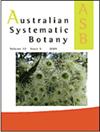对Englerodendron属(豆科-豆科)的重新评价,包括异巨球藻和假巨球藻
IF 1.6
3区 生物学
Q4 EVOLUTIONARY BIOLOGY
引用次数: 8
摘要
本文以一种新的刺蕨科植物系统发育为基础,重点研究了刺蕨(Englerodendron Harms)。并讨论了划分单系属的可能选择。结果,奥布氏异构体。& Pellegr。与假巨巨藻同属于英格兰树属。以下12个新组合在扩大的英枝中形成:E. brachyrhachhis (Breteler) Estrella & Ojeda, E. explicans (Baill.)Estrella & Ojeda, E. hallei (aubrsamv .)E. Estrella & Ojeda, E. isopettalum (Harms) Breteler & Wieringa, E. lebrunii (j.l onard) Estrella & Ojeda, E. leptorrhachhis (Harms) Estrella & Ojeda, E. mengei (De Wild)Estrella & Ojeda, E.尼日利亚(Baker f.)Estrella & Ojeda, E. obanense (Baker f.)Estrella & Ojeda, E.三重体(Pellegr)Estrella & Ojeda和E. vignei (Hoyle) Estrella & Ojeda。一个关键,以鉴定17种,现在认识到在英枝属提出。本文章由计算机程序翻译,如有差异,请以英文原文为准。
Re-evaluation of the genus Englerodendron (Leguminosae–Detarioideae), including Isomacrolobium and Pseudomacrolobium
On the basis of a new phylogeny of the Detarioideae, with a particular focus on Englerodendron Harms, Anthonotha P.Beauv. and related genera, the possible options for delimiting monophyletic genera are discussed. As a result, Isomacrolobium Aubrév. & Pellegr. and Pseudomacrolobium Hauman are synonymised under Englerodendron. The following 12 new combinations are formed within the expanded Englerodendron: E. brachyrhachis (Breteler) Estrella & Ojeda, E. explicans (Baill.) Estrella & Ojeda, E. graciliflorum (Harms) Estrella & Ojeda, E. hallei (Aubrév.) Estrella & Ojeda, E. isopetalum (Harms) Breteler & Wieringa, E. lebrunii (J.Léonard) Estrella & Ojeda, E. leptorrhachis (Harms) Estrella & Ojeda, E. mengei (De Wild.) Estrella & Ojeda, E. nigericum (Baker f.) Estrella & Ojeda, E. obanense (Baker f.) Estrella & Ojeda, E. triplisomere (Pellegr.) Estrella & Ojeda and E. vignei (Hoyle) Estrella & Ojeda. A key to identification of the 17 species now recognised within Englerodendron is presented.
求助全文
通过发布文献求助,成功后即可免费获取论文全文。
去求助
来源期刊

Australian Systematic Botany
生物-进化生物学
CiteScore
3.10
自引率
12.50%
发文量
12
审稿时长
>12 weeks
期刊介绍:
Australian Systematic Botany is an international journal devoted to the systematics, taxonomy, and related aspects of biogeography and evolution of all algae, fungi and plants, including fossils. Descriptive taxonomic papers should normally constitute a comprehensive treatment of a group. Short papers on individual species and nomenclatural papers must contain significant new information of broader interest to be considered. The prestigious L.A.S. Johnson Review Series is published. Other review articles will also be considered. All papers are peer reviewed.
Australian Systematic Botany is published with the endorsement of the Commonwealth Scientific and Industrial Research Organisation (CSIRO) and the Australian Academy of Science.
 求助内容:
求助内容: 应助结果提醒方式:
应助结果提醒方式:


